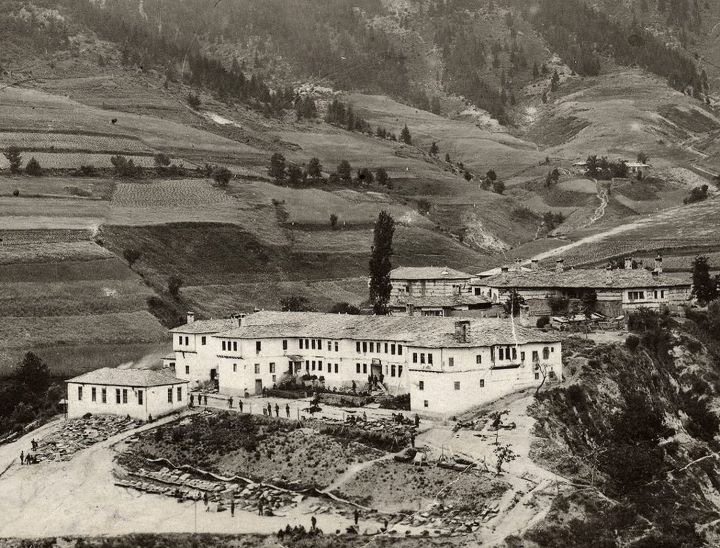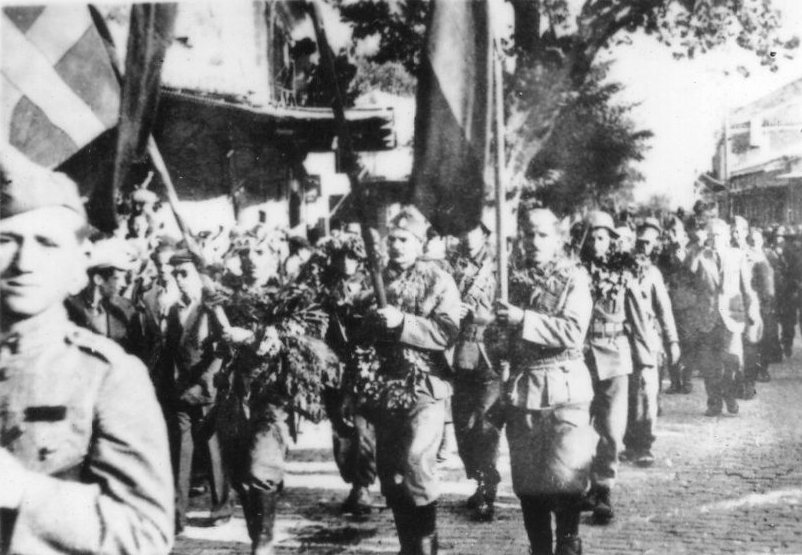|
Petar Mandjukov
Petar Georgiev Mandzhukov (Bulgarian Петър Георгиев Манджуков and mk, Петар Манџуков) (July 20, 1878 – January 1, 1966) was a Macedonian Bulgarian revolutionary and anarchist, member of the Internal Macedonian-Adrianople Revolutionary Organization and of the Supreme Macedonian-Adrianople Committee. Biography He was born in 1878 in the village of Mirkovci, then in the Ottoman Empire, today in North Macedonia. Mandzhukov was a brother of the Colonel of the Bulgarian Army Spas Mandzhukov. He was a nephew is Metropolitan Nathanael of Ohrid, who lead him to Plovdiv, Eastern Rumelia, where he studied at a high school. Mandzhukov became one of the founders of the anarchist Macedonian Secret Revolutionary Committee there and was therefore excluded from the school. He graduated later from a pedagogical school in Lom and afterwards studied chemistry at the University of Geneva, where he became a member of the anarchist Geneva group. In the autumn ... [...More Info...] [...Related Items...] OR: [Wikipedia] [Google] [Baidu] |
Petar Mandzhukov IMARO Mirkovtsi
Petar ( sr, Петар, bg, Петър) is a South Slavic masculine given name, their variant of the Biblical name Petros cognate to Peter. Derivative forms include Pero, Pejo, Pera, Perica, Petrica, Periša. Feminine equivalent is Petra. People mononymously known as Petar include: * Petar of Serbia ( – 917), early Prince of the Serbia * Petar of Duklja (), early archont in Dioclea * Petar Krešimir (died 1074/1075), King of Croatia and Dalmatia * * Notable people with the name are numerous: * See also * Sveti Petar (other) * Petrić * Petričević Petričević ( sr-cyr, Петричевић) is a Serbo-Croatian surname, a patronymic derived from ''Petrič'', a diminutive of Petar. It may refer to: *Bogdan Petričević (born 1989), Montenegrin handball player *Luka Petričević (born 1992), M ... References {{reflist Serbian masculine given names Bulgarian masculine given names Croatian masculine given names ... [...More Info...] [...Related Items...] OR: [Wikipedia] [Google] [Baidu] |
Slavi Merdjanov
Svetoslav Chanev Merdzanov (1876–1901) was Bulgarian anarchist and revolutionary. He was better known as Slave or Slavi Merdzhanov. Merdzhanov was founder of the group called the Gemidzii, which organized the Thessaloniki bombings of 1903. Biography He was born on 16 July 1876 in Karnobat, then part of the Ottoman Empire. While he was still studying at the Ruse High school, thanks to the influence of the libertarian Varban Kilifarski, he joined the anarchist group of this city on the Danube and so did not finish high education. After working for a time in a notary, he went to Geneva (Switzerland) to study law, but became here part of the anarchist " Geneve group", founded in 1898 by Petar Mandjukov and closely related to the Internal Macedonian-Adrianople Revolutionary Organization (IMARO). Following his decision to devote himself to the struggle for the liberation of Macedonia and Thrace from Ottoman rule, he went in 1899 to Skopje where, after some time, he was arrested by ... [...More Info...] [...Related Items...] OR: [Wikipedia] [Google] [Baidu] |
Peshtera
Peshtera ( bg, Пещера , sometimes transliterated as ''Peštera''; rup, Peshtera) is a town in the Rhodope Mountains, southern Bulgaria. It is located in Pazardzhik Province near the towns of Batak and Bratsigovo. The town is the third largest in the province after Pazardzhik and Velingrad and is the forty-fifth largest in Bulgaria. It is the administrative center of the municipality Peshtera. According to the 2021 census, Peshtera has a population of 15,175 inhabitants. At about 5 km to the south, along the road to Batak, is one of the most visited caves in Bulgaria — Snezhanka. Near the town is located the Peshtera Hydroelectric Power Station. The town is well known for producing the alcohol beverage mastika under the brand ''Peshterska''. Geography Peshtera (461 m asl) is located in the foothills of the Rhodope Mountains, at 18 km from Pazardzhik and 38 km from Plovdiv and 125 km from the national capital Sofia. The local climate is temperate ... [...More Info...] [...Related Items...] OR: [Wikipedia] [Google] [Baidu] |
Karlovo
Karlovo ( bg, Карлово ) is a historically important town in central Bulgaria located in a fertile valley along the river Stryama at the southern foot of the Balkan Mountains. It is administratively part of Plovdiv Province and has a population of about 30,340 (), the mayor being Dr. Emil Kabaivanov. Karlovo is famous for the worldwide-known rose oil, which is grown there and used in producing perfume. In addition to this, Karlovo is the birthplace of Vasil Levski, the most distinguished Bulgarian to start preparing the national liberation from the Ottoman rule in the late 19th century. There is a museum and large monument dedicated to him. Karlovo is also a popular location for tourism in the region. During the 2000s, Bulgarian archaeologists made discoveries in Central Bulgaria which were summarized as 'The Valley of the Thracian Kings'. On 19 August 2005, some archaeologists announced they had found the first Thracian capital, which was situated near Karlovo in Bul ... [...More Info...] [...Related Items...] OR: [Wikipedia] [Google] [Baidu] |
Kazanlak
Kazanlak ( bg, Казанлък , Thracian and Greek Σευθόπολις (''Seuthopolis''), tr, Kazanlık) is a Bulgarian town in Stara Zagora Province, located in the middle of the plain of the same name, at the foot of the Balkan mountain range, at the eastern end of the Rose Valley. It is the administrative centre of the homonymous Kazanlak Municipality. The town is among the 15 biggest industrial centres in Bulgaria, with a population of 44,760 people as of Dec 2017.Bulgarian National Statistical Institute – towns in 2017 It is the center of |
Mihail Gerdjikov
} Mihail Gerdzhikov ( bg, Михаил Герджиков; 1877–1947) was a Bulgarian revolutionary and anarchist. Biography He was born in Plovdiv, then in the Ottoman Empire, in 1877. He studied at the French College in Plovdiv, where he received the nickname ''Michel''. As a student in 1893 he started his revolutionary activities as the leader of a Macedonian Secret Revolutionary Committee (MSRC). In Lausanne and Geneva he participated in the so-called ''Geneva Group''. In 1899 he returned to the Bulgarian lands and became a teacher at Bulgarian Classical High School in Bitola and joined IMORO, where Gerdzhikov approached Gotse Delchev. In 1900 he was a delegate to the Zlatitsa Society of the ''Seventh Macedonian Congress''. In April 1901 he was a delegate of the Borisov Society to the ''Eighth Macedonian-Edirne Congress''. After the defeat of the Strandzha commune he dealt with the accommodation of the rebels who withdrew to Bulgaria. He published articles in the Bu ... [...More Info...] [...Related Items...] OR: [Wikipedia] [Google] [Baidu] |
Smolyan
Smolyan ( bg, Смолян) List of cities and towns in Bulgaria, is a town and ski resort in the south of Bulgaria near the border with Greece. It is the administrative and industrial centre of the homonymous Smolyan Province. The town is built along the valley of Cherna ("Black") and Byala River, Byala ("White") rivers in the central Rhodope Mountains which makes him the longest city in Bulgaria. It is also located at foot of the mountain's highest peak Golyam Perelik - 2191m. Smolyan is just 10-15 minutes drive from the popular ski resorts Pamporovo and Chepelare. As of June 2022 it has a population of 30 689 inhabitants. Name The name of the town comes from the local Slavic tribe of the Smolyani, the name of whom is probably cognate to the Slavic word ''smola'' ("resin"). History According to archaeological evidence, the area around Smolyan was first settled in the 2nd millennium BC, 2nd-1st millennium BC. In the Middle Ages it acquired its name from the Slavic peoples, Sla ... [...More Info...] [...Related Items...] OR: [Wikipedia] [Google] [Baidu] |
Thessaloniki Bombings Of 1903
The Boatmen of Thessaloniki ( bg, Гемиджиите; mk, Гемиџиите) or the Assassins of Salonica, was a Bulgarian anarchist group, active in the Ottoman Empire in the years between 1898 and 1903. The members of the Group were predominantly from Veles and most of them − young graduates from the Bulgarian Men's High School of Thessaloniki. The group was radicalized by the Bulgarian anarchist Slavi Merdzhanov, whose initial target was the capital Constantinople, and subsequently Adrianople, but after his execution by the Ottomans in 1901, the group's attention shifted to Thessaloniki. From 28 April until 1 May 1903 the group launched a campaign of terror bombing in Thessaloniki. Their aim was to attract the attention of the Great Powers to Ottoman oppression in Macedonia and Thrace. The group's roots can be traced to 1898 in Geneva, and nearly all its founders were natives from Bulgaria. It was associated with the Internal Macedonian-Adrianople Revolutionary Org ... [...More Info...] [...Related Items...] OR: [Wikipedia] [Google] [Baidu] |
Thessaloniki
Thessaloniki (; el, Θεσσαλονίκη, , also known as Thessalonica (), Saloniki, or Salonica (), is the second-largest city in Greece, with over one million inhabitants in its Thessaloniki metropolitan area, metropolitan area, and the capital city, capital of the geographic regions of Greece, geographic region of Macedonia (Greece), Macedonia, the administrative regions of Greece, administrative region of Central Macedonia and the Decentralized Administration of Macedonia and Thrace. It is also known in Greek language, Greek as (), literally "the co-capital", a reference to its historical status as the () or "co-reigning" city of the Byzantine Empire alongside Constantinople. Thessaloniki is located on the Thermaic Gulf, at the northwest corner of the Aegean Sea. It is bounded on the west by the delta of the Vardar, Axios. The Thessaloniki (municipality), municipality of Thessaloniki, the historical center, had a population of 317,778 in 2021, while the Thessaloniki metro ... [...More Info...] [...Related Items...] OR: [Wikipedia] [Google] [Baidu] |
Xanthi
Xanthi ( el, Ξάνθη, ''Xánthi'', ) is a city in the region of Western Thrace, northeastern Greece. It is the capital of the Xanthi (regional unit), Xanthi regional unit of the modern regions of Greece, region of East Macedonia and Thrace. Amphitheatrically built on the foot of Rhodope mountains, Rhodope mountain chain, the city is divided by the Kosynthos River, into the west part, where the old and the modern town are located, and the east part that boasts a rich natural environment. The "Old Town of Xanthi" is known throughout Greece for its distinctive architecture, combining many Byzantine Greeks, Byzantine Greek churches with neoclassicism, neoclassical mansions of Greek merchants from the 18th and 19th centuries and Ottoman-Era mosques. Other landmarks in Xanthi include the Archaeological Museum of Abdera, Thrace, Abdera and the Greek Folk Art Museum. Xanthi is famous throughout Greece (especially Macedonia (Greece), Macedonia and Western Thrace, Thrace) for its annual ... [...More Info...] [...Related Items...] OR: [Wikipedia] [Google] [Baidu] |
Rhodope Mountains
The Rhodopes (; bg, Родопи, ; el, Ροδόπη, ''Rodopi''; tr, Rodoplar) are a mountain range in Southeastern Europe, and the largest by area in Bulgaria, with over 83% of its area in the southern part of the country and the remainder in Greece. Golyam Perelik is its highest peak at . The mountain range gives its name to the terrestrial ecoregion Rodope montane mixed forests that belongs in the temperate broadleaf and mixed forests biome and the Palearctic realm. The region is particularly notable for its karst areas with their deep river gorges, large caves and specific sculptured forms, such as the Trigrad Gorge. A significant part of Bulgaria's hydropower resources are located in the western areas of the range. There are a number of hydro-cascades and dams used for electricity production, irrigation, and as tourist destinations. In Greece, there are also the hydroelectric power plants of Thisavros and Platanovrysi. The Rhodopes have a rich cultural heritage including a ... [...More Info...] [...Related Items...] OR: [Wikipedia] [Google] [Baidu] |








